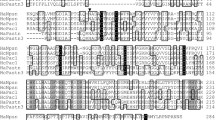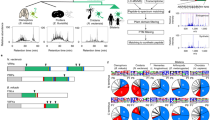Abstract
Dipeptidyl peptidase-4 (DPP4) is a serine protease of great interest because it has been shown to modulate the activity of several peptidergic factors including peptide YY (PYY) and glucagon-like peptide-1/2. While PYY(1–36) is orexigenic in mammals, PYY(3–36) recently garnered interest as a potent anorexigen. In silico phylogenetic analysis found that the DPP4 cleavage sites are absent in fish PYY sequences. However, no studies were conducted to show that indeed PYY(3–36) is not produced by DPP4 in fish. If DPP4 does not cleave PYY(1–36), is PYY(3–36) an anorexigen in fish? The objectives of this research were to (1) test whether DPP4 cleaves goldfish PYY(1–36) and (2) determine whether PYY(3–36) is an anorexigen in goldfish. First, we identified the highly conserved catalytic region of DPP4 in goldfish. Abundant expression of DPP4 mRNA was found within the gastrointestinal tract. We also report the first MALDI-MS cleavage analysis of DPP4 effects on PYY(1–36) in a non-mammalian vertebrate. Our novel results indicate that DPP4 is unable to cleave goldfish PYY(1–36) to PYY(3–36) in vitro. It also confirms a previously held hypothesis that DPP4 is unable to cleave fish PYY(1–36) that contains N-terminal proline–proline residues. PYY(3–36) had no effects on food intake of goldfish. The appetite inhibitory effects of intraperitoneal and intracerebroventricular injections of 10 ng/g body weight gfPYY(1–36) were abolished by coinjections of BIBP3226, a Y1 receptor antagonist. These results are significant because it shows the lack of generation of endogenous PYY(3–36) and its anorectic effects in goldfish.








Similar content being viewed by others
References
Abbott CR, Small CJ, Kennedy AR, Neary NM, Sajedi A, Ghatei MA, Bloom SR (2005) Blockade of the neuropeptide Y Y2 receptor with the specific antagonist BIIE0246 attenuates the effect of endogenous and exogenous peptide YY(3–36) on food intake. Brain Res 1043:139–144
Abbott CR et al (2006) The importance of acclimatisation and habituation to experimental conditions when investigating the anorectic effects of gastrointestinal hormones in the rat. Int J Obes 30:288–292
Adrian TE, Ferri GL, Bacarese-Hamilton AJ, Fuessl HS, Polak JM, Bloom SR (1985) Human distribution and release of a putative new gut hormone, peptide YY. Gastroenterology 89:1070–1077
Batterham RL et al (2002) Gut hormone PYY(3–36) physiologically inhibits food intake. Nature 418:650–654
Batterham RL et al (2003) Pancreatic polypeptide reduces appetite and food intake in humans. J Clin Endocrinol Metab 88:3989–3992
Bernstein HG, Schon E, Ansorge S, Rose I, Dorn A (1987) Immunolocalization of dipeptidyl aminopeptidase (DAP IV) in the developing human brain. Int J Dev Neurosci 5:237–242
Bongers J, Lambros T, Ahmad M, Heimer EP (1992) Kinetics of dipeptidyl peptidase IV proteolysis of growth hormone-releasing factor and analogs. Biochim Biophys Acta 1122:147–153
Burnstock G (1958) Reversible inactivation of nervous activity in a fish gut. J Physiol 141:35–45
Cerda-Reverter JM, Martinez-Rodriguez G, Anglade I, Kah O, Zanuy S (2000a) Peptide YY (PYY) and fish pancreatic peptide Y (PY) expression in the brain of the sea bass (Dicentrarchus labrax) as revealed by in situ hybridization. J Comp Neurol 426:197–208
Cerda-Reverter JM, Martinez-Rodriguez G, Zanuy S, Carrillo M, Larhammar D (2000b) Molecular evolution of the neuropeptide Y (NPY) family of peptides: cloning of three NPY-related peptides from the sea bass (Dicentrarchus labrax). Regul Pept 95:25–34
Chelikani PK, Haver AC, Reidelberger RD (2004) Comparison of the inhibitory effects of PYY(3–36) and PYY(1–36) on gastric emptying in rats. Am J Physiol Regul Integr Comp Physiol 287:R1064–R1070
Chelikani PK, Haver AC, Reidelberger RD (2005) Intravenous infusion of peptide YY(3–36) potently inhibits food intake in rats. Endocrinology 146:879–888
Chelikani PK, Haver AC, Reidelberger RD (2007) Intermittent intraperitoneal infusion of peptide YY(3–36) reduces daily food intake and adiposity in obese rats. Am J Physiol Regul Integr Comp Physiol 293:R39–R46
Christoffels A, Koh EG, Chia JM, Brenner S, Aparicio S, Venkatesh B (2004) Fugu genome analysis provides evidence for a whole-genome duplication early during the evolution of ray-finned fishes. Mol Biol Evol 21:1146–1151
Degen L, Oesch S, Casanova M, Graf S, Ketterer S, Drewe J, Beglinger C (2005) Effect of peptide YY3–36 on food intake in humans. Gastroenterology 129:1430–1436
Dereeper A et al (2008) Phylogeny.fr: robust phylogenetic analysis for the non-specialist. Nucleic Acids Res 36:W465–W469
Drucker DJ et al (1997) Regulation of the biological activity of glucagon-like peptide 2 in vivo by dipeptidyl peptidase IV. Nat Biotechnol 15:673–677
Eberlein GA et al (1989) A new molecular form of PYY: structural characterization of human PYY(3–36) and PYY(1–36). Peptides 10:797–803
Fredriksson R, Sjodin P, Larson ET, Conlon JM, Larhammar D (2006) Cloning and characterization of a zebrafish Y2 receptor. Regul Pept 133:32–40
Fukasawa KM, Fukasawa K, Sahara N, Harada M, Kondo Y, Nagatsu I (1981) Immunohistochemical localization of dipeptidyl aminopeptidase IV in rat kidney, liver, and salivary glands. J Histochem Cytochem 29:337–343
Gonzalez R, Unniappan S (2010) Molecular characterization, appetite regulatory effects and feeding related changes of peptide YY in goldfish. Gen Comp Endocrinol 166:273–279
Grandt D, Schimiczek M, Struk K, Shively J, Eysselein VE, Goebell H, Reeve JR Jr (1994) Characterization of two forms of peptide YY, PYY(1–36) and PYY(3–36), in the rabbit. Peptides 15:815–820
Hagan MM, Moss DE (1995) Effect of peptide YY (PYY) on food-associated conflict. Physiol Behav 58:731–735
Jaillon O et al (2004) Genome duplication in the teleost fish Tetraodon nigroviridis reveals the early vertebrate proto-karyotype. Nature 431:946–957
Kanatani A et al (2000) Role of the Y1 receptor in the regulation of neuropeptide Y-mediated feeding: comparison of wild-type, Y1 receptor-deficient, and Y5 receptor-deficient mice. Endocrinology 141:1011–1016
Kato T, Hama T, Nagatsu T, Kuzuya H, Sakakibara S (1979) Changes of X-prolyl dipeptidyl-aminopeptidase activity in developing rat brain. Experientia 35:1329–1330
Kenny AJ, Booth AG, George SG, Ingram J, Kershaw D, Wood EJ, Young AR (1976) Dipeptidyl peptidase IV, a kidney brush-border serine peptidase. Biochem J 157:169–182
Kurokawa T, Suzuki T (2002) Development of neuropeptide Y-related peptides in the digestive organs during the larval stage of Japanese flounder, Paralichthys olivaceus. Gen Comp Endocrinol 126:30–38
Lambeir AM, Durinx C, Scharpe S, De Meester I (2003) Dipeptidyl-peptidase IV from bench to bedside: an update on structural properties, functions, and clinical aspects of the enzyme DPP IV. Crit Rev Clin Lab Sci 40:209–294
Larhammar D (1996) Structural diversity of receptors for neuropeptide Y, peptide YY and pancreatic polypeptide. Regul Pept 65:165–174
McCaughan GW, Wickson J, Gorrell MD (1990) Characterization of the rat CD26 antigen. Transplant Proc 22:2103–2104
Mentlein R (1999) Dipeptidyl-peptidase IV (CD26)–role in the inactivation of regulatory peptides. Regul Pept 85:9–24
Mentlein R, Dahms P, Grandt D, Kruger R (1993) Proteolytic processing of neuropeptide Y and peptide YY by dipeptidyl peptidase IV. Regul Pept 49:133–144
Mentzel S, Dijkman HB, Van Son JP, Koene RA, Assmann KJ (1996) Organ distribution of aminopeptidase A and dipeptidyl peptidase IV in normal mice. J Histochem Cytochem 44:445–461
Moran TH, Smedh U, Kinzig KP, Scott KA, Knipp S, Ladenheim EE (2005) Peptide YY(3–36) inhibits gastric emptying and produces acute reductions in food intake in rhesus monkeys. Am J Physiol Regul Integr Comp Physiol 288:R384–R388
Morley JE, Levine AS, Grace M, Kneip J (1985) Peptide YY (PYY), a potent orexigenic agent. Brain Res 341:200–203
Murashita K, Kurokawa T, Nilsen TO, Ronnestad I (2009) Ghrelin, cholecystokinin, and peptide YY in Atlantic salmon (Salmo salar): molecular cloning and tissue expression. Gen Comp Endocrinol 160:223–235
Peter RE, Gill VE (1975) A stereotaxic atlas and technique for forebrain nuclei of the goldfish, Carassius auratus. J Comp Neurol 159:69–101
Rudolf K et al (1994) The first highly potent and selective non-peptide neuropeptide Y Y1 receptor antagonist: BIBP3226. Eur J Pharmacol 271:R11–R13
Sloth B, Holst JJ, Flint A, Gregersen NT, Astrup A (2007) Effects of PYY1–36 and PYY3–36 on appetite, energy intake, energy expenditure, glucose and fat metabolism in obese and lean subjects. Am J Physiol Endocrinol Metab 292:E1062–E1068
Söderberg C, Pieribone VA, Dahlstrand J, Brodin L, Larhammar D (1994) Neuropeptide role of both peptide YY and neuropeptide Y in vertebrates suggested by abundant expression of their mRNAs in a cyclostome brain. J Neurosci Res 37:633–640
Söderberg C, Wraith A, Ringvall M, Yan YL, Postlethwait JH, Brodin L, Larhammar D (2000) Zebrafish genes for neuropeptide Y and peptide YY reveal origin by chromosome duplication from an ancestral gene linked to the homeobox cluster. J Neurochem 75:908–918
Sterchi EE (1981) The distribution of brush border peptidases along the small intestine of the adult human. Pediatr Res 15:884–885
Sundstrom G, Larsson TA, Brenner S, Venkatesh B, Larhammar D (2008) Evolution of the neuropeptide Y family: new genes by chromosome duplications in early vertebrates and in teleost fishes. Gen Comp Endocrinol 155:705–716
Thompson JD, Higgins DG, Gibson TJ (1994) CLUSTAL W: improving the sensitivity of progressive multiple sequence alignment through sequence weighting, position-specific gap penalties and weight matrix choice. Nucleic Acids Res 22:4673–4680
Tschop M et al (2004) Physiology: does gut hormone PYY3–36 decrease food intake in rodents? Nature 430:1
Unniappan S, McIntosh CH, Demuth HU, Heiser U, Wolf R, Kieffer TJ (2006) Effects of dipeptidyl peptidase IV on the satiety actions of peptide YY. Diabetologia 49:1915–1923
van Niel G, Raposo G, Candalh C, Boussac M, Hershberg R, Cerf-Bensussan N, Heyman M (2001) Intestinal epithelial cells secrete exosome-like vesicles. Gastroenterology 121:337–349
Volkoff H, Canosa LF, Unniappan S, Cerda-Reverter JM, Bernier NJ, Kelly SP, Peter RE (2005) Neuropeptides and the control of food intake in fish. Gen Comp Endocrinol 142:3–19
Zhou L, Irwin DM (2004) Fish proglucagon genes have differing coding potential. Comp Biochem Physiol B Biochem Mol Biol 137:255–264
Acknowledgments
This work was funded by the Natural Sciences and Engineering Research Council (NSERC) of Canada through a Discovery grant, and a Discovery Accelerator Supplement. Infrastructure support for our laboratory is provided by the John R. Evans Leaders Fund from the Canada Foundation for Innovation, and an Establishment grant from the Saskatchewan Health Research Foundation to SU. SU is a recipient of the Canadian Institutes of Health Research New Investigator Salary Award. We thank Naresh Ramesh for assistance with reference list formatting.
Author information
Authors and Affiliations
Corresponding author
Electronic supplementary material
Below is the link to the electronic supplementary material.
Rights and permissions
About this article
Cite this article
Gonzalez, R., Unniappan, S. Mass spectrometry-assisted confirmation of the inability of dipeptidyl peptidase-4 to cleave goldfish peptide YY(1–36) and the lack of anorexigenic effects of peptide YY(3–36) in goldfish (Carassius auratus). Fish Physiol Biochem 42, 831–844 (2016). https://doi.org/10.1007/s10695-015-0178-y
Received:
Accepted:
Published:
Issue Date:
DOI: https://doi.org/10.1007/s10695-015-0178-y




